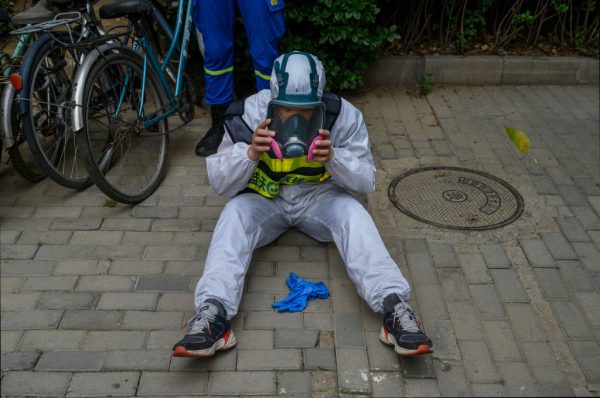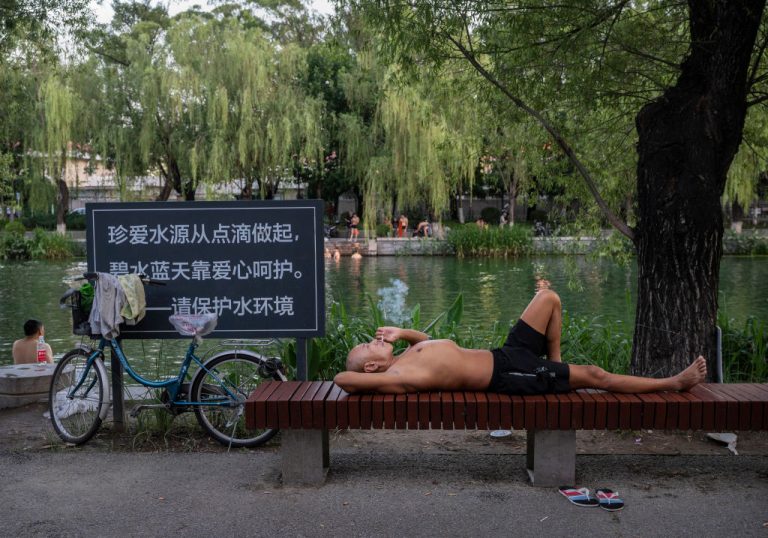A massive heatwave sweeping through China has forced residents to seek refuge in “air-raid shelters” and public fountains as temperatures reach a staggering 40 degrees Celsius (104 degrees Fahrenheit) in parts of the country.
According to China’s Central Meteorological Observatory, since July 6, a total of 18 provinces and over 80 cities have experienced extreme temperatures above 35° C (95° F.) The afflicted areas include the southern Xinjiang Basin, central and western Inner Mongolia, Gansu, northeastern Qinghai, Ningxia, Anhui, Jiangsu, Zhejiang, Shanghai, etc.
The country’s Meteorological Observatory added that the daily temperature in the Sichuan basin and Guanzhong plain in Shaanxi Province were recorded at times to have even exceeded 40° C.
MORE ON CLIMATE CRISES:
- India Bakes Under Unprecedented Heat; Millions Seek Refuge Indoors While Crops Fail, Electricity Demand Skyrockets
- Massive Flooding in China Submerges Roads, Traps Residents Inside Leaking Buildings
- Torrential Downpours Kill Dozens of People in Southern China
- Monsoon Floods Descend on Bangladesh and India, Millions Rendered Homeless, Dozens Dead
‘Barbecue mode’
On July 10, Shanghai’s Central Meteorological Observatory issued a “high-temperature red warning” — the highest level of alert in the country — and likened the scorching heat waves to have reached life-threatening levels, or so-called, “barbecue mode.”
The agency added that the recorded temperature of 40.9°C at the Xujiahui Station in Shanghai was the highest recorded since modern record keeping began in 1942, and since meteorological records began in 1873.
Success
You are now signed up for our newsletter
Success
Check your email to complete sign up
Sweltering residents in Shanghai could be seen frying eggs on pavements, and many people were reportedly hospitalized for symptoms of heat stroke. Meanwhile, vendors in the city reported surging sales of ice cream, fruit, and crayfish chilled in liquor — a popular summertime snack. At a sprawling Shanghai wildlife park, eight metric tons of ice were being used each day to keep lions, pandas and other animals from overheating, according to CNN.
Shanghai’s Weather News reported that the city’s orange warning had been bumped to a red “high-temperature” alert on July 13, and urged residents to stay hydrated and avoid going outside if possible.
Multiple dead, dozens hospitalized
According to state-backed outlet The Paper, high temperatures in the eastern coastal province of Zhejiang resulted in numerous people being hospitalized for life-threatening heat stroke. The report said that many hospitals in the area saw consecutive days of patients coming in for heat stroke-symptoms, and some reportedly died — though the exact number is unknown.

On July 6, a 49-year-old man was brought into the hospital by a coworker after suddenly collapsing in a workshop, according to the report. By the time he was admitted, his internal body temperature had reached 40.7° C — causing him to go into shock.
Wu Jianrong, an emergency doctor at Lishui Central Hospital, told The Paper that after being admitted and stabilized, the patient suffered from multiple organ failure and passed away in the early hours of July 8 after undergoing 31 hours of CPR.
According to government statistics, Lishui Central Hospital has seen at least three patients admitted in the past week for heat stroke symptoms. Among them, a 70-year-old woman was seen suffering from impaired consciousness and a high fever after she reportedly took a nap inside her home where temperatures had reached over 42.5° C.
Another male patient from Zhengzhou was also critically hospitalized after doctors said his core temperature had reached 42.3° C — resulting in all his organs essentially “being boiled alive.” The patient was then admitted into the hospital’s ICU wing, and it remains unclear whether he survived.
Power rationing to return
After holding a provincial-wide meeting on July 11, The Zhejiang Provincial Energy Bureau announced that certain “high-energy-consuming” companies and factories would have their electricity rationed in an effort to prevent future power outages.
The notice said that the power curtailment or “rotational maintenance of high-energy-consuming enterprises,” would see certain factories receive notices in the coming weeks. A few textile and polyester manufacturers in Hangzhou, Shaoxing and Haining reported having already received notices of the upcoming power curbs, though the details were not revealed.

According to data from China’s National Bureau of Statistics, the country’s industrial output has fallen by over 25 percent from January to May of this year. In particular, profits from coal-fired plants have seen a nosedive due to an ongoing coal shortage that resulted in massive power cuts last year.
Ye Chun, deputy director of China’s Electricity Council, said that since August 2021, the country’s coal-powered sector had incurred massive losses — with some enterprises reporting losses of up to 100 percent.
China’s national economy has also been in decline due to the communist authorities’ unrelenting implementation of “zero-COVID” protocols that have shuttered businesses, cut consumer spending and halted factory production.














